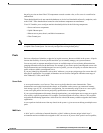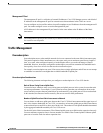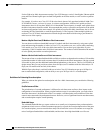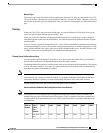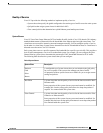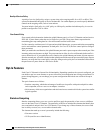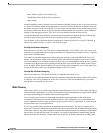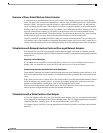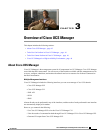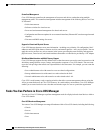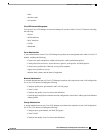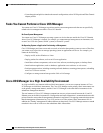
• MAC address (used for LAN connectivity)
• World Wide Names (used for SAN connectivity)
• Boot settings
Stateless computing creates a dynamic server environment with highly flexible servers. Every physical server
in a Cisco UCS domain remains anonymous until you associate a service profile with it, then the server gets
the identity configured in the service profile. If you no longer need a business service on that server, you can
shut it down, disassociate the service profile, and then associate another service profile to create a different
identity for the same physical server. The "new" server can then host another business service.
To take full advantage of the flexibility of statelessness, the optional local disks on the servers should only
be used for swap or temp space and not to store operating system or application data.
You can choose to fully implement stateless computing for all physical servers in a Cisco UCS domain, to
not have any stateless servers, or to have a mix of the two types.
If You Opt In to Stateless Computing
Each physical server in the Cisco UCS domain is defined through a service profile. Any server can be used
to host one set of applications, then reassigned to another set of applications or business services, if required
by the needs of the data center.
You create service profiles that point to policies and pools of resources that are defined in the Cisco UCS
domain. The server pools, WWN pools, and MAC pools ensure that all unassigned resources are available
on an as-needed basis. For example, if a physical server fails, you can immediately assign the service profile
to another server. Because the service profile provides the new server with the same identity as the original
server, including WWN and MAC address, the rest of the data center infrastructure sees it as the same server
and you do not need to make any configuration changes in the LAN or SAN.
If You Opt Out of Stateless Computing
Each server in the Cisco UCS domain is treated as a traditional rack mount server.
You create service profiles that inherit the identify information burned into the hardware and use these profiles
to configure LAN or SAN connectivity for the server. However, if the server hardware fails, you cannot
reassign the service profile to a new server.
Multi-Tenancy
Multi-tenancy allows you to divide up the large physical infrastructure of an Cisco UCS domain into logical
entities known as organizations. As a result, you can achieve a logicalisolation between organizations without
providing a dedicated physical infrastructure for each organization.
You can assign unique resources to each tenant through the related organization, in the multi-tenant
environment. These resources can include different policies, pools, and quality of service definitions. You
can also implement locales to assign or restrict user privileges and roles by organization, if you do not want
all users to have access to all organizations.
If you set up a multi-tenant environment, all organizations are hierarchical. The top-level organization is
always root. The policies and pools that you create in root are system-wide and are available to all organizations
in the system. However, any policies and pools created in other organizations are only available to organizations
that are above it in the same hierarchy. For example, if a system has organizations named Finance and HR
that are not in the same hierarchy, Finance cannot use any policies in the HR organization, and HR cannot
Cisco UCS Manager GUI Configuration Guide, Release 2.0
OL-25712-04 39
Opt-In Features



